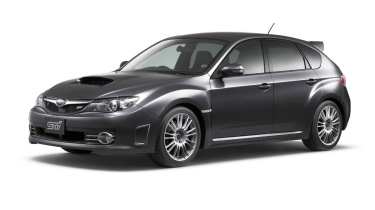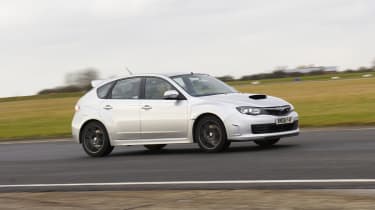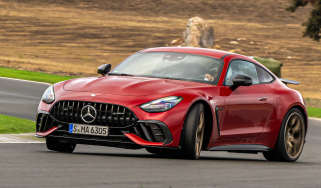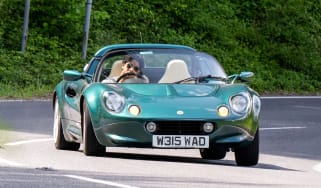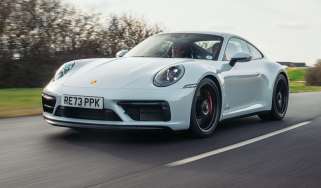2008 Subaru Impreza WRX STI (MY08) revealed
Purposeful bulging-arch look for hatchback STI
Impreza versus Lancer. It’s a battle that’s been fought on rally stages and showroom floors for more than a decade, and one that’s about to intensify thanks to the simultaneous launch early next year of Mitsubishi’s dramatic Evo X and this, the all-new Subaru Impreza WRX STI.
While this month sees us amongst the first to drive the new Evo X and also getting our first UK steer in a new Impreza, a Japanese-market S-GT model, as we went to press we also received these first official images of the forthcoming STI.
Pictures aside, Subaru has given nothing away about its high-performance Impreza. But despite the shortage of official information, not only have we been able to piece together a more detailed picture of what the new STI will look like – thanks to scoop shots of a virtually undisguised car testing at the Nürburgring Nordschleife – but we’ve also nailed key details of its as-yet-undisclosed hardware.
After universal shock and subsequent bemusement at Subaru’s decision to ditch the Impreza’s traditional four-door-saloon profile for a frumpy five-door hatchback, it’s a great relief to see that not only does the STI look seriously purposeful, but with the well-executed set of blistered wheelarches, potent turbocharged engine, all-wheel-drive chassis and obvious rallying influence, Subaru is reviving a compelling concept last perfected by Lancia with the iconic Delta Integrale.
Wider in track and longer in wheelbase, yet lighter and shorter overall than the saloon it succeeds, the new STI boasts a bigger footprint for greater stability and outright grip than its forebear. Gone are the rear suspension’s MacPherson struts, replaced by a new multi-link set-up, and, just as in the old STI saloon, the new car’s longer suspension arms will be made from cast aluminium rather than the pressed steel of the narrow-track WRX’s items.Late-generation STI saloons featured underfloor aerodynamics taken from the homologation Spec C model, and from the look of the new car’s rear diffuser it’s clear the five-door wears a development of these stability-enhancing devices.
Attractive 18-spoke, 18in alloys are fitted as standard, with 245/40 Bridgestone Potenza RE050A tyres, although more extreme trackday-spec tyres could be an option.
Naturally the STI’s springs and dampers will be firmer, as will the suspension bushing material for a more direct and positive feel. Bigger hubs carry the familiar Brembo brakes, although the callipers now sport STI branding. Subaru has also been seen running cars at the Nordschleife with six-pot front callipers, which could point to an upgrade option, or that Subaru Tecnica International is still working on the lighter and more focused Spec C homologation special, which was due to be available from launch but is now rumoured to have been delayed by up to a year.Beneath the gaping bonnet scoop, the STI’s hardware remains broadly the same as that seen in the last- generation STI saloon, although there are some major differences between the specifications of the Japanese domestic model and that destined for overseas. In Japan the new car is still powered by the 2-litre version of the trademark four-cylinder boxer engine, boosted by a twin-scroll turbocharger. In Europe and the US, STIs are fitted with the larger 2.5-litre motor complete with single-scroll turbo, although as with the old STI saloon, US cars develop 296bhp versus 276bhp for the European model. While outputs for all three are broadly similar, our experience of both motors suggests the smaller-capacity unit is the sweeter, keener revving engine, so it’s a shame we won’t be getting it in the UK (as an official model, at least).
Unlike the Evo X, which comes with either a five-speed manual or optional six-speed DSG-style sequential transmission, Subaru has retained the trusty six-speed manual gearbox from the outgoing STI saloon, along with the driver-adjustable DCCD centre differential, which tailors the handling balance for different road conditions.
Expected to be making its debut in the Impreza is Subaru’s SI-Drive (Subaru Intelligent Drive) system, which is already featured on the Legacy. Controlled by a rotary switch located close to the gearlever, SI-Drive offers three different driving modes: ‘Intelligent’, which reduces torque and power, softens throttle response and improves fuel consumption; ‘Sport’, which gives full torque and power along with a keener throttle response, and ‘Sport Sharp’, which sharpens the throttle still further for ultimate response. The adoption of SI-Drive may also point to the STI’s engine featuring variable valve timing on both intake and exhaust valves, as this both enhances the engine’s performance potential and lowers emissions.
While no official weight or performance figures had been released at the time of writing, the new STI should weigh-in between 10 and 20kg lighter than the old 1495kg STI saloon, and therefore be at least as rapid. Expect a 0-60mph time close to 5sec dead and a top speed of 160mph. Crucially, that makes it a shade quicker and lighter than the basic Evo X. The STI should also maintain its traditional price advantage over the Mitsubishi, with an estimated price of between £27,000 and £28,000.
Both cars are due to arrive in the UK in March 2008.
